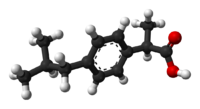
Photo from wikipedia
Introduction and aims Overdose is a common presentation in Emergency Departments (EDs) across the UK. Salicylate poisoning is potentially fatal; however it is becoming increasingly uncommon in the UK. This… Click to show full abstract
Introduction and aims Overdose is a common presentation in Emergency Departments (EDs) across the UK. Salicylate poisoning is potentially fatal; however it is becoming increasingly uncommon in the UK. This may be due to restriction of pack sizes in over the counter medicines as well as the use of aspirin as an analgesic being superseded by other NSAIDs, particularly ibuprofen. In conjunction with clinical features of salicylate toxicity, measurement of plasma salicylate concentration can help guide management. Many EDs routinely test for salicylate levels in all cases of overdose, and yet this may not be necessary as recommended by the NPIS. This study aims to assess the cost implication of over testing for salicylate in overdose patients, as well as the prevalence of salicylate poisoning in three EDs in the West Midlands. Method A multicentre retrospective case note study was undertaken from January 2016 to March 2017. Data were collected from 3 EDs in the West Midlands. Cases of overdose where salicylate levels were requested were identified in conjunction with biochemistry departments, and information gathered regarding age, gender, nature of overdose, patient weight, GCS, clinical features of salicylate toxicity and plasma salicylate concentration. Results Across the three centres, 4296 requests were made for salicylate levels during the study period. Of those samples, just 115 detected any salicylate at all (2.7%). The majority of these samples had levels just over limit of detection. This is in keeping with the previous observation that salicylate poisoning is uncommon. Of the 4296 samples sent, 3651 were not indicated, i.e., no clinical features, patient alert, and denied aspirin overdose. With the cost of plasma salicylate concentration analysis being £4.58 (average over the 3 sites) there is a potential cost saving of £16 721 per year. Conclusions Salicylate poisoning appears to be uncommon among patients presenting with overdose. Results show that it is likely that EDs are over testing for salicylate levels. In accordance with NPIS advice, there is no need to measure salicylate levels in conscious overdose patients who have no features of toxicity and deny salicylate ingestion. This may have cost implications, allowing departments to save money by reducing the amount of routine salicylate testing overall.
Journal Title: Emergency Medicine Journal
Year Published: 2017
Link to full text (if available)
Share on Social Media: Sign Up to like & get
recommendations!